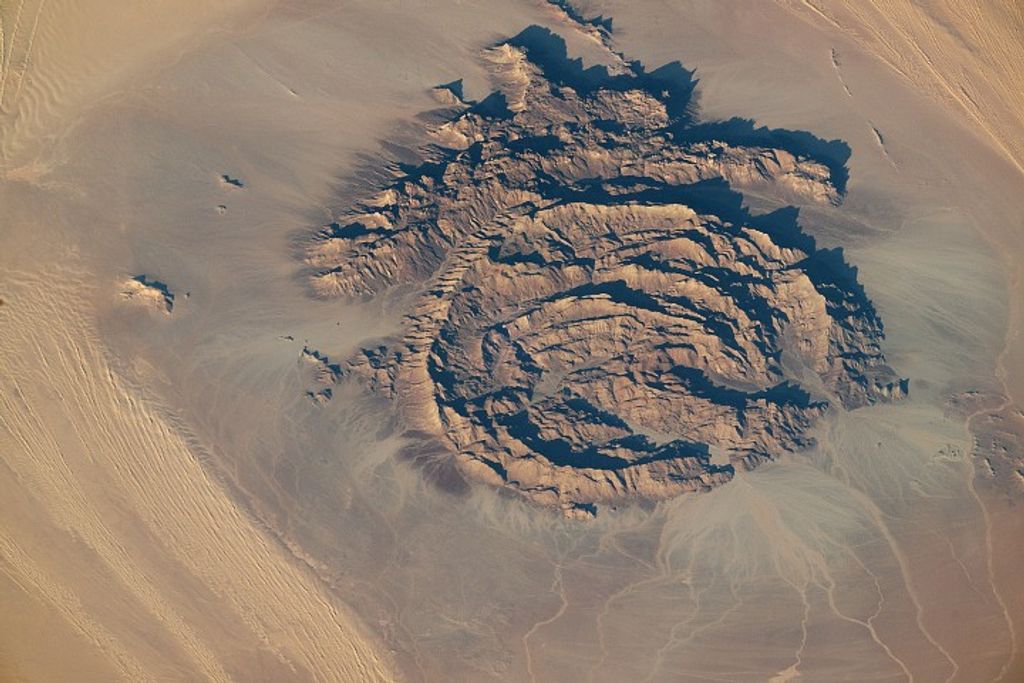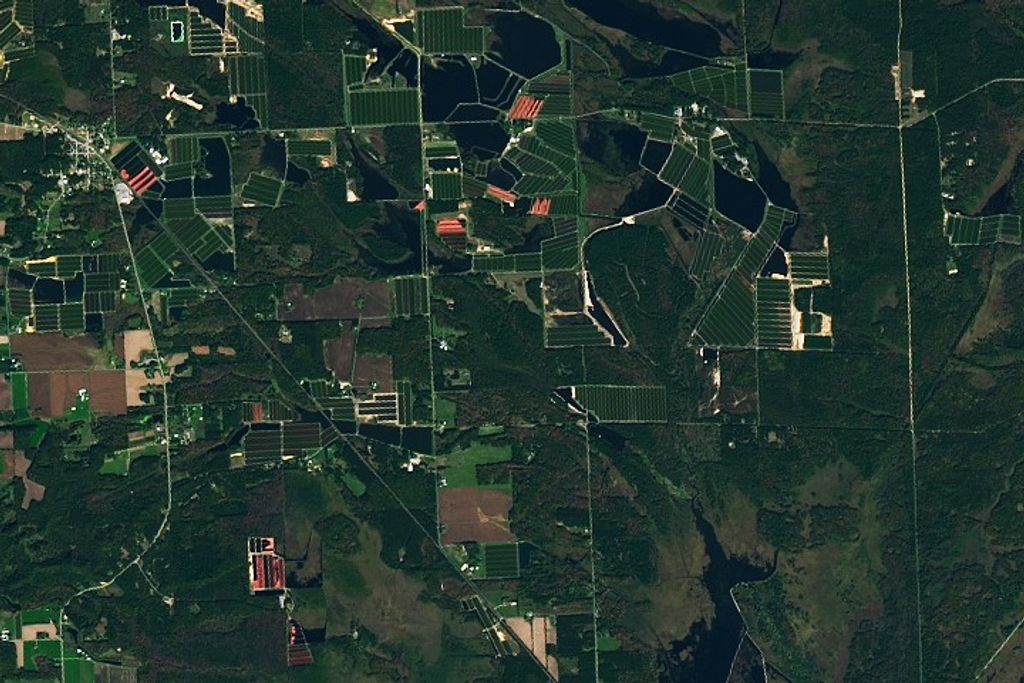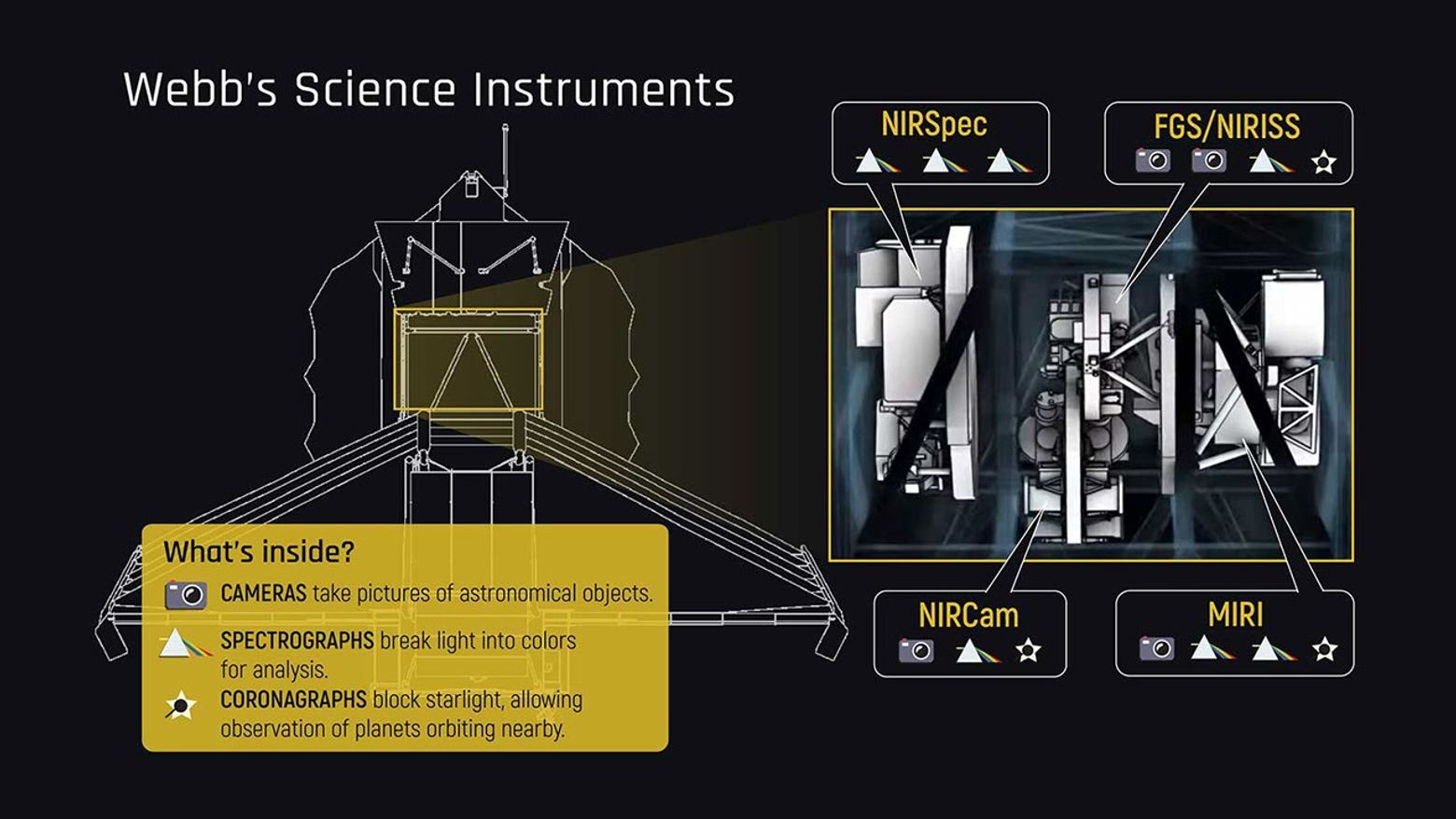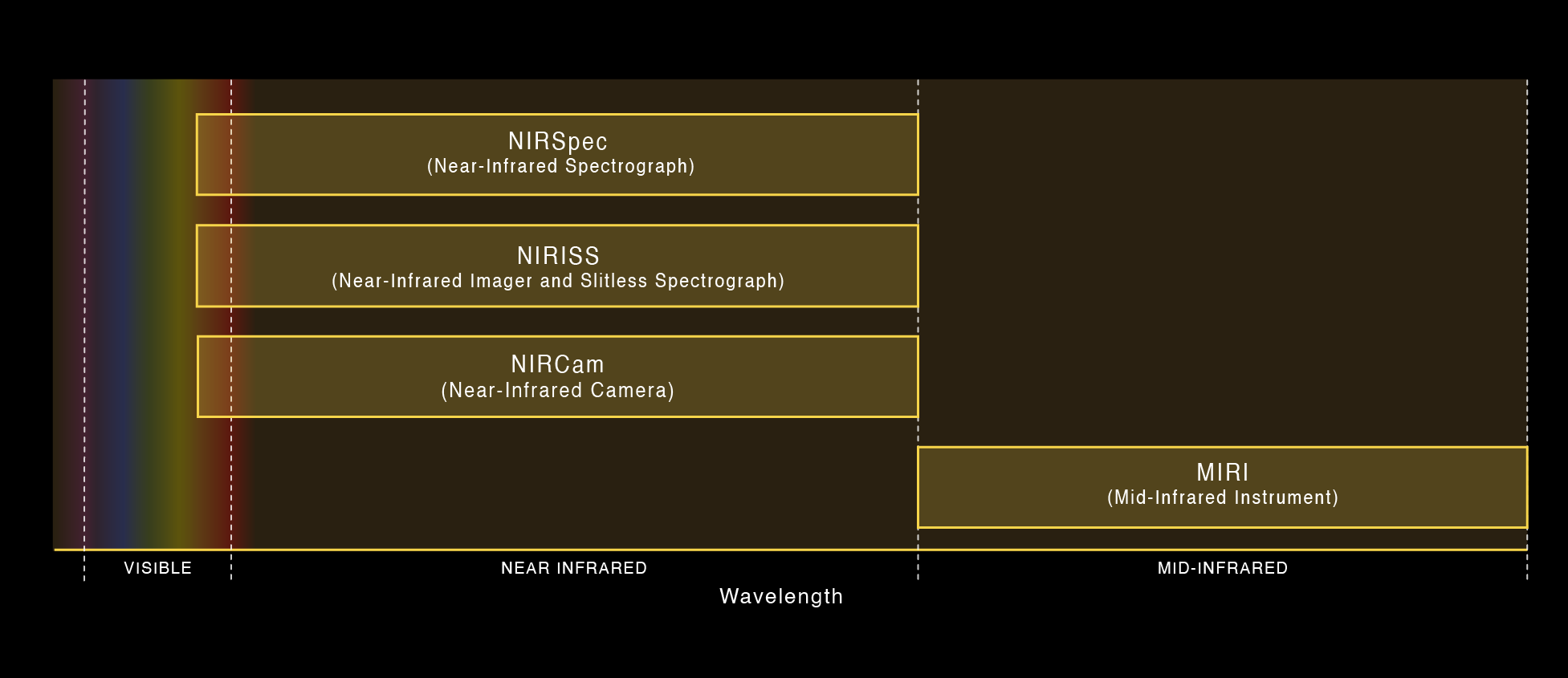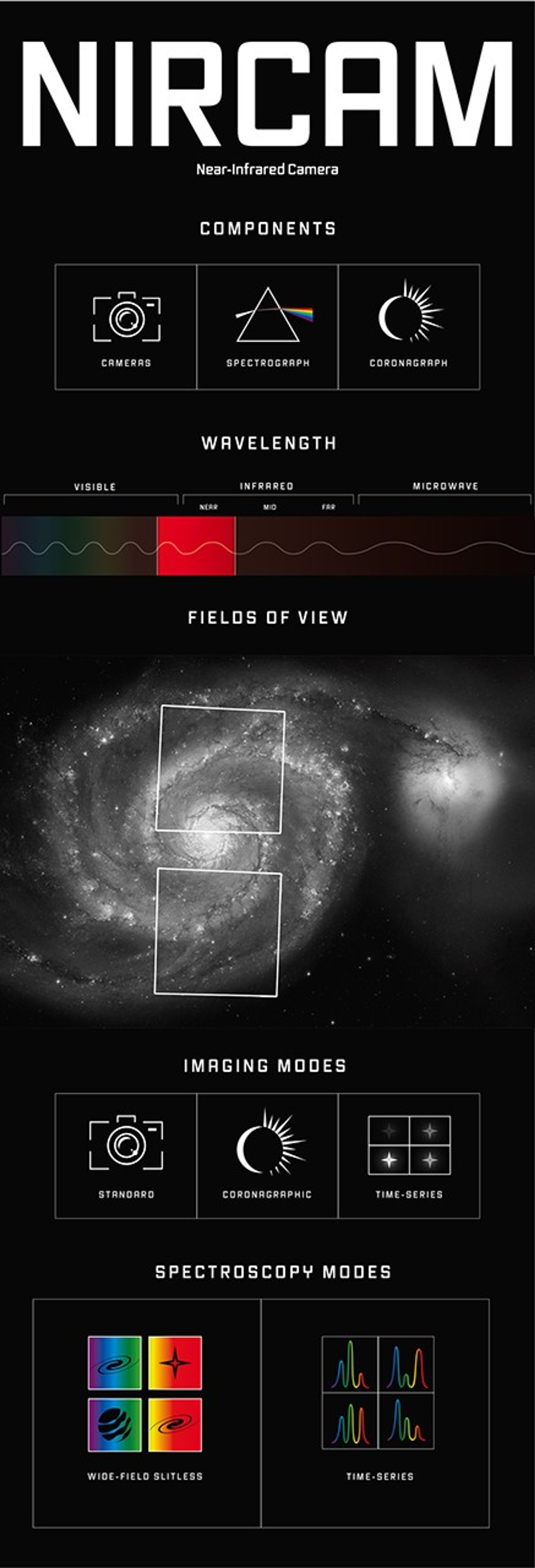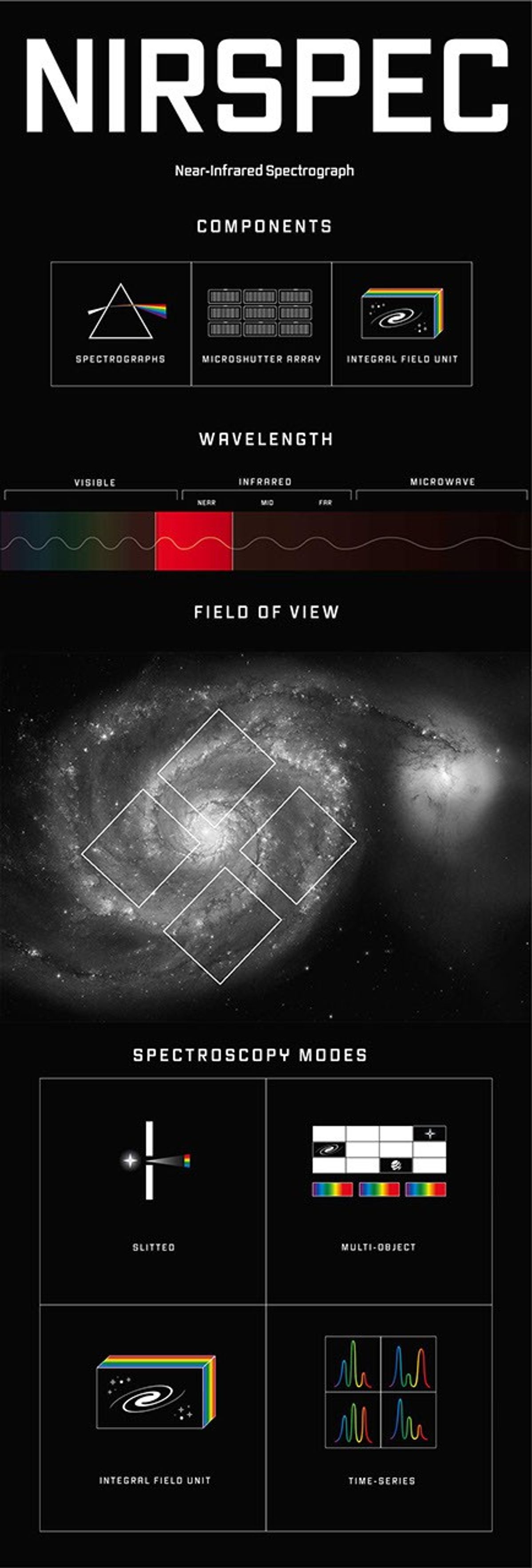Webb’s Scientific Instruments
Contents
- Tools for Capturing the Cosmos
- About Webb's Instruments
- Overview
- Instrument Components
- Observing Modes
- Imaging with Webb
- Imaging Modes
- Spectroscopy with Webb
- Spectroscopy Modes
- Instrument Wavelength Range, Field of View, and Resolution
- Wavelength Range
- Field of View
- Resolution
- Instrument Detail
- Mid-Infrared Instrument (MIRI)
- Near-Infrared Camera (NIRCam)
- Near-Infrared Spectrograph (NIRSpec)
- Near-Infrared Imager and Slitless Spectrograph (NIRISS)/Fine Guidance Sensor (FGS)
- Additional Resources
Tools for Capturing the Cosmos
Webb’s unprecedented scientific power is a function of both the size of its primary mirror and the extreme sensitivity and precision of its four scientific instruments:
- Mid-Infrared Instrument (MIRI)
- Near-Infrared Camera (NIRCam)
- Near-Infrared Spectrograph (NIRSpec)
- Near-Infrared Imager and Slitless Spectrograph/Fine Guidance Sensor (NIRISS/FGS)
All scientific journal articles and many press releases will refer to specific instruments, instrument components, or observing modes used for observations with Webb.
This section provides some clarity on the function of each component, observing mode, and instrument, and the types of observations they are designed for.
About Webb's Instruments
Overview
Unlike simple backyard telescopes, which focus light from space directly into the eye, research telescopes include scientific instruments that record light precisely. Scientific instruments are crucial elements in both ground- and space-based telescopes, and are designed to optimize observations for scientific use.
During an observation with Webb, infrared light travelling from the target object or region of space is intercepted by the primary mirror, reflected onto the smaller secondary mirror, and then focused into the Integrated Science Instrument Module (ISIM). Mirrors then direct the light into one or more of the four scientific instruments, which may focus, filter, block, or disperse the light before it is recorded.
| Each of Webb’s four instruments is like a Swiss army knife of more specialized components, with multiple ways of observing (observing modes). Although some instruments are more suitable than others for observing specific types of objects, all four can be used for investigations of the wide variety of objects that make up the universe, including planets, stars, nebulae, and galaxies. |
|---|
Instrument Components
Each of Webb’s four instruments includes a set of components that are common in research telescopes, along with components that are more specialized.
Common Components
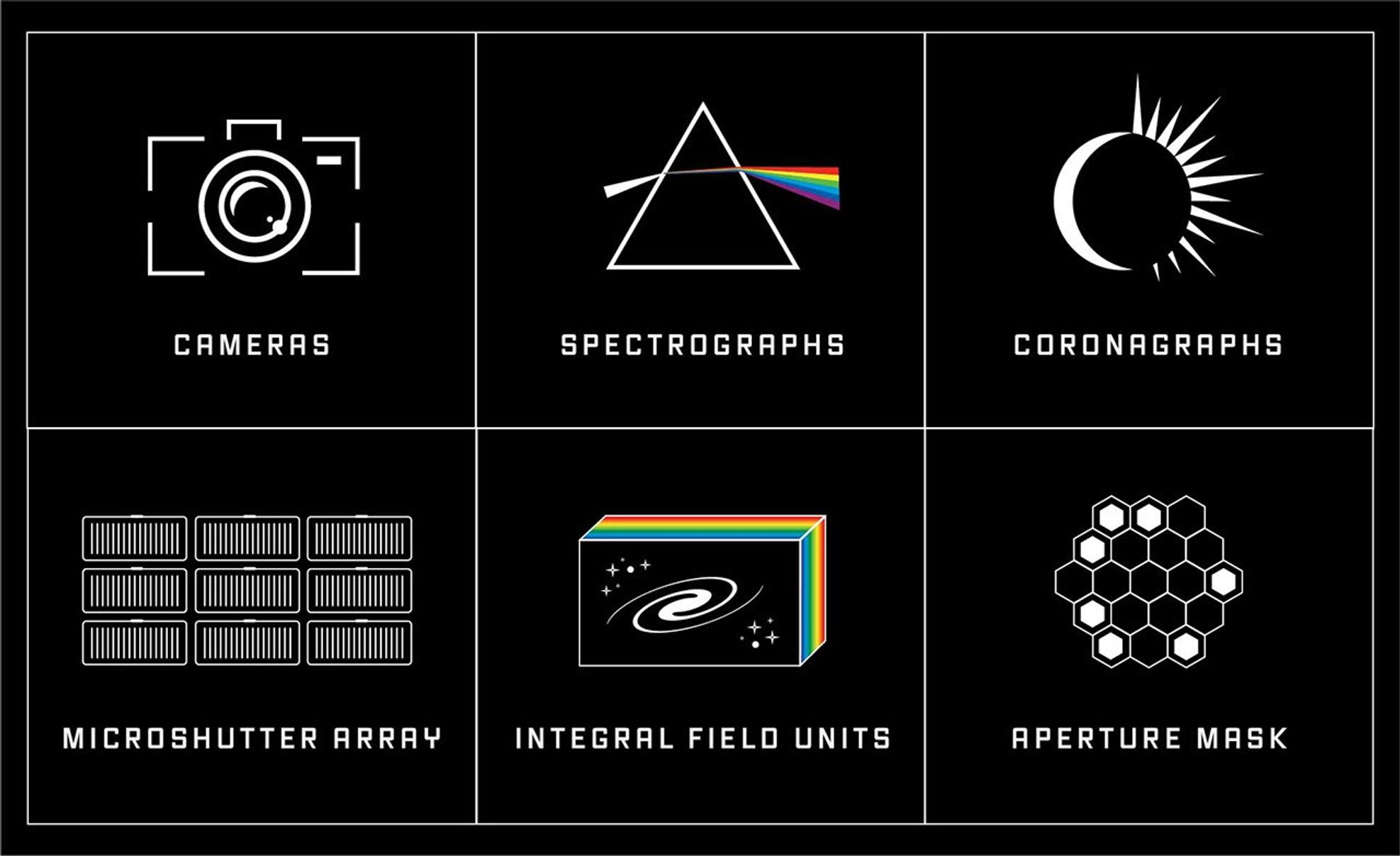
Cameras capture two-dimensional images of regions of space. NIRCam and NIRISS capture images in the near-infrared, while MIRI captures mid-infrared images. NIRSpec is the only instrument without a camera.
Spectrographs spread light out into a spectrum so that the brightness of each individual wavelength can be measured. Webb has a number of different types of spectrographs, each designed for a slightly different purpose. All four of Webb’s instruments have spectrographs.
Coronagraphs are opaque disks used to block the bright light of stars in order to detect the much fainter light of planets and debris disks orbiting the star. NIRCam and MIRI have coronagraphs.
Filters are thin sheets of specialized materials designed to transmit a certain range of wavelengths of light and block all others. Webb’s filters are similar to light filters on handheld cameras, and are used in conjunction with cameras, coronagraphs, and spectrographs. All four instruments include numerous filters, including broad-band filters, which transmit a wide range of wavelengths; narrow-band filters, which transmit a very narrow range of wavelengths; and clear filters, which transmit all wavelengths collected by the telescope.
Detectors absorb light and convert it into electrical charges so that the information carried in the light (brightness, wavelength, and position) can be stored as digital data before being converted into radio signals and transmitted to Earth. Detectors are arranged in arrays, and are equivalent to the CCDs in a digital camera or the film in an analog camera. All four instruments have at least two detectors. NIRSpec, NIRISS, and NIRCam detectors are sensitive to near-infrared light (0.6 – 4.9 µm). MIRI detectors are sensitive to mid-infrared light (4.9 – 28.8 microns).
Specialized Components
Webb’s microshutter array (MSA) is a grid of 248,000 tiny doors that can be opened and closed to transmit or block light in order to capture spectra of 100 individual objects or points in space at the same time (multi-object spectroscopy). NIRSpec is the only instrument with an MSA, and Webb is the only space telescope with an MSA.
The integral field unit (IFU) is a combination of camera and spectrograph used to capture and map spectra across a field of view in order to understand variation over space. NIRSpec and MIRI have IFUs.
Webb’s aperture mask is a metal plate with seven hexagonal holes that is placed in front of the detectors to increase the effective resolution of the telescope and capture more detailed images of extremely bright objects (aperture mask interferometry). NIRISS is the only instrument with an aperture mask.
Observing Modes
When astronomers plan observations with Webb, they choose not only their target of interest, but also the various observing modes required to address specific scientific questions. Observing modes on Webb are similar to modes on a digital camera. Different observing modes involve different combinations of components. Astronomers commonly observe the same target using more than one mode.
There are two broad groups of observation modes: imaging and spectroscopy.
Imaging with Webb
Imaging is equivalent to digital photography. Imaging is used to detect objects in a large field of view; map the spatial relationship between various objects and materials in space; and investigate the shape and structure of individual objects.
During imaging, infrared light from space is passed through filters onto an array of detectors. The detectors measure the intensity (brightness) of infrared light at thousands of points (pixels) across the field of view.
Imaging Modes
Webb has four imaging modes. All imaging modes employ filters and detectors, as well as cameras.
Standard Imaging is the equivalent to basic digital photography and involves capturing pictures of a wide variety of objects and materials in space that emit or reflect infrared light. (NIRCam, NIRISS, and MIRI)
Coronagraphic Imaging (sometimes called high-contrast imaging) involves using a coronagraph to block the light of a star in order to reveal the much dimmer light of nearby objects, such as exoplanets and debris disks. (NIRCam and MIRI)
Aperture Mask Interferometry (AMI) involves using an aperture mask to increase the effective resolution of the telescope and capture more detailed images. When the aperture mask is in place, only the light that passes through the holes makes it to the detectors—the rest is blocked. AMI simulates the effect of a telescope array, in which a number of telescopes work together to simulate the light gathering ability of a single, much larger telescope. AMI is used to separate light of bright objects like stars that are close together in space or on the sky. (NIRISS)
Time-Series Imaging involves capturing a series of images at regular intervals in order to measure changes over time. Time series is sort of like burst mode on a camera, and can be used to track changes in the brightness of a star or can be combined with coronagraphic imaging to track the motion of a planet. (MIRI and NIRCam)
Spectroscopy with Webb
Spectroscopy involves spreading light out into a spectrum in order to analyze the intensity (or brightness) of individual colors, or wavelengths. Differences in brightness with wavelength, and the presence or absence of specific wavelengths, provides information about temperature, composition, density, motion, and distance.
During a spectroscopic observation, light from space is directed through a spectrograph, which spreads the light out into its component wavelengths. The light then strikes the detectors, which measure the intensity (brightness) of each individual wavelength of light. Spectral data are typically plotted on a graph of intensity vs. wavelength.
Spectroscopy Modes
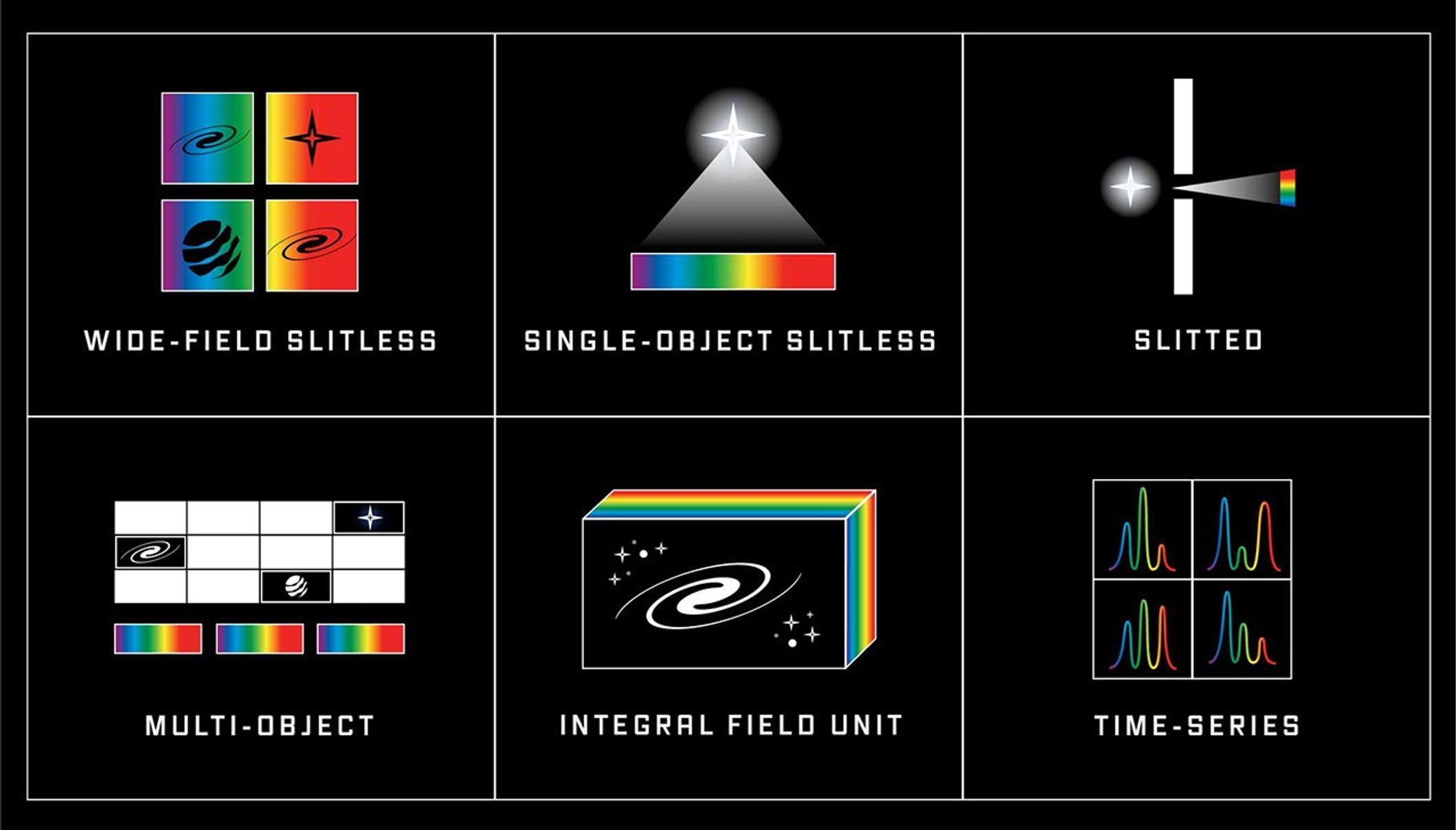
Webb has six spectroscopy modes. All spectroscopy modes involve filters and detectors as well as spectrographs.
Wide-Field Slitless Spectroscopy involves capturing the overall spectrum of a wide field of view – a field of stars, part of a nearby galaxy, or many galaxies at once. (NIRCam and NIRISS)
Single-Object Slitless Spectroscopy involves capturing the spectrum of a single bright object like a star in a field of view. (MIRI and NIRISS)
Slit Spectroscopy provides the ability to capture the spectrum of a single object—a single star, a single exoplanet, or a single distant galaxy—in a wide field of view. Single slit spectroscopy is also used to analyze the spectrum of a small area of an object that is large in the field of view, such as a galaxy or planet. (NIRSpec and MIRI)
Multi-Object Spectroscopy involves using a microshutter array to capture individual spectra of up to 100 objects or locations in space at one time. Multi-object spectroscopy is important for efficiency, in particular when observing very distant and dim targets, such as ancient galaxies, which require hundreds of hours of observation time. (NIRSpec)
Integral Field Unit Spectroscopy (IFU) involves a combination of imaging and spectroscopy. During an IFU observation, the instrument captures an image of the field of view along with individual spectra of each pixel in the field of view. IFU observations allow astronomers to investigate how properties—such as composition, temperature, and motion—vary between different objects such as stars in a crowded star field, or from place to place over a large region of space such as a galaxy or nebula. (NIRSpec and MIRI)
Time-Series Spectroscopy involves capturing the spectrum of an object or region of space at regular intervals in order to observe how the spectrum changes over time. Time series spectroscopy is used to study planets as they transit their stars. (NIRCam, NIRSpec, and MIRI)
Instrument Wavelength Range, Field of View, and Resolution
Wavelength Range
Webb is designed to capture light ranging in wavelength from 0.6 microns (visible red) to 27.9 microns (mid-infrared). Each instrument, however, covers only part of the full range, and each observing mode may cover an even smaller portion of the instrument’s range. The wavelength coverage determines which specific scientific questions can be answered.
The near-infrared instruments (NIRCam, NIRSpec, and NIRISS) cover 0.6-5 microns, while the Mid-Infrared Instrument (MIRI) covers 4.9-27.9 microns.
Field of View
An instrument’s field of view is the amount of sky that it can observe at any given point in time. Each instrument has a field of view that is unique in area, shape, and orientation. In some cases, different observing modes within an instrument cover fields of view of different sizes and shapes.
Resolution
In general, resolution—the size of the smallest details that can be resolved in an image (spatial resolution), or the degree with which wavelengths of light can be differentiated in a spectrum (spectral resolution)—is a function of the size of Webb’s primary mirror and the wavelength of light (longer wavelengths have lower resolution). However, the actual resolution of an image or spectrum varies with observing mode and instrument. Researchers rely on this information to ensure that observations will yield data of sufficient resolution.
Instrument Detail
Each of Webb’s four instruments is designed to study a wide range of objects and phenomena in space, including planets, stars, galaxies, gas clouds, debris disks, black holes, and dark matter.
What makes each instrument unique is its specific combination of components, observing modes, wavelength range, field of view, and resolution.
While some investigations are conducted with a single instrument and observing mode, most rely on a combination of instruments and/or observing modes.
Mid-Infrared Instrument (MIRI)
Components: Camera, Coronagraphs, Spectrographs, Integral Field Unit
Wavelength range: 4.9 µm – 27.9 µm (mid-infrared, which is unique to MIRI)
Detectors: Arsenic-doped silicon
Imaging modes: Standard Imaging, Coronographic Imaging, Time-Series Imaging
Spectroscopy modes: Single-Object Slitless Spectroscopy, Slit Spectroscopy, Integral Field Unit Spectroscopy, Time-Series Spectroscopy
Resolution: Medium-resolution imaging; Low- and medium-resolution spectroscopy
MIRI provides imaging and spectroscopy capabilities in the mid-infrared. As the only mid-infrared instrument, astronomers rely on MIRI to study cooler objects like debris disks, which emit most of their light in the mid-infrared, and extremely distant galaxies whose light has been shifted into the mid-infrared over time.
MIRI was developed through a collaboration between the European Consortium (EC) and the Jet Propulsion Laboratory (JPL).
Near-Infrared Camera (NIRCam)
Components: Camera, Coronagraphs, Spectrographs
Wavelength range: 0.6 µm – 5 µm (red to near-infrared)
Detectors: Mercury cadmium telluride
Imaging modes Standard Imaging, Coronagraphic Imaging, Time-Series Imaging
Spectroscopy modes: Wide-Field Slitless Spectroscopy, Time-Series Spectroscopy
Resolution: High-resolution imaging and spectroscopy
NIRCam is Webb’s primary near-infrared imager, providing high-resolution imaging and spectroscopy for a wide variety of investigations. Because NIRCam is the only near-infrared instrument with coronagraphic and time-series imaging capabilities, it is crucial for many exoplanet studies.
In addition to imaging and spectroscopy, NIRCam is also part of Webb’s wavefront sensing and control system, which detects and corrects for slight irregularities in the shape of the primary mirror or misalignment between mirror segments, giving the telescope the ability to focus clearly on objects near and far.
NIRCam was built by a team at the University of Arizona and Lockheed Martin’s Advanced Technology Center.
Near-Infrared Spectrograph (NIRSpec)
Components: Spectrographs, Integral Field Unit, Microshutter Array (Unique to NIRSpec)
Wavelength range: 0.6 µm – 5.3 µm (red to near-infrared)
Detectors: Mercury cadmium telluride
Imaging modes: N/A (with the exception of images collected during Integral Field Unit Spectroscopy)
Spectroscopy modes: Slit Spectroscopy, Multi-Object Spectroscopy (Unique to NIRSpec), Integral Field Unit Spectroscopy, Time-Series Spectroscopy
Resolution: Low-, Medium-, and High-resolution spectroscopy
NIRSpec is one of Webb’s versatile tools for near-infrared spectroscopy. In addition to standard single-slit spectroscopy to gather spectra of specific objects, NIRSpec also has an integral field unit to investigate spatial variations in spectra and a microshutter array to capture individual spectra of dozens of objects at once. This highly efficient design is part of what makes Webb ideal for studying extremely distant, faint galaxies.
NIRSpec was built for the European Space Agency by Airbus Industries with the microshutter array (MSA) and detector sub-systems fabricated by NASA.
Near-Infrared Imager and Slitless Spectrograph (NIRISS)/Fine Guidance Sensor (FGS)
Components: Camera, Spectrographs, Aperture Mask
Wavelength range: 0.6 µm – 5 µm (red to near-infrared)
Detectors: Mercury cadmium telluride
Imaging modes: Standard Imaging, Aperture Mask Interferometry (Unique to NIRISS)
Spectroscopy modes: Wide-Field Slitless Spectroscopy, Single-Slit Spectroscopy
Resolution: High-resolution imaging; Low- and Medium-resolution spectroscopy
NIRISS provides near-infrared imaging and spectroscopic capabilities. As the only instrument capable of aperture mask interferometry, NIRISS has the unique ability to capture images of bright objects at a resolution greater than the other imagers.
Housed in the same assembly as NIRISS is Webb’s Fine Guidance Sensor (FGS). The FGS is a camera system designed to make sure Webb is stable and pointing in exactly the right direction throughout the observation. The FGS detects and identifies guide stars and ensures that Webb is locked onto those stars for the entire observation.
NIRISS is a contribution of the Canadian Space Agency. Honeywell International designed and built the instrument in collaboration with a team at the Université de Montréal. Additional technical support was provided by the National Research Council of Canada’s Herzberg Astronomy and Astrophysics Research Centre.
Additional Resources
Find out more about Webb’s instruments from NASA's Goddard Space Flight Center.
Learn more about Webb’s detectors.
Dive deep into the technical details of Webb’s instruments.
Find more details on different observing modes.








